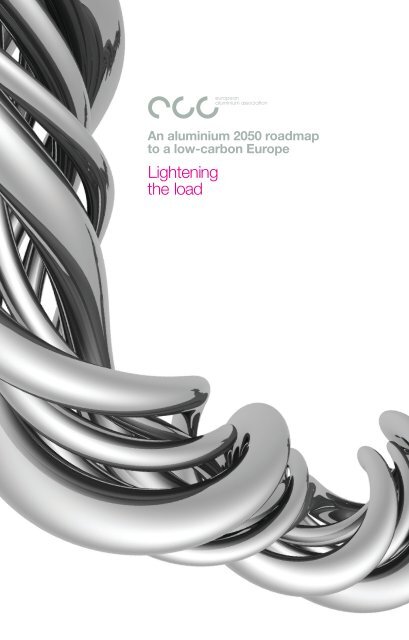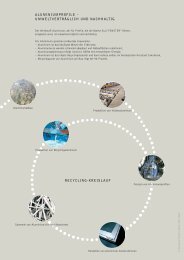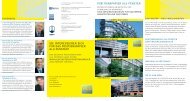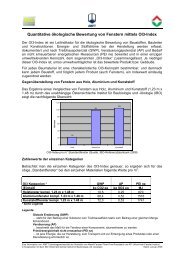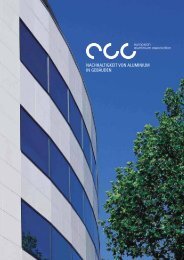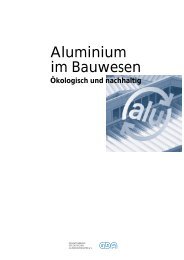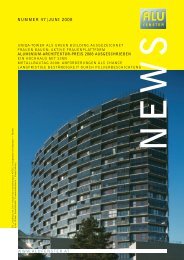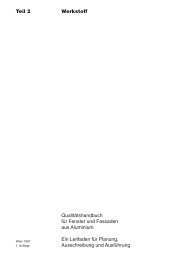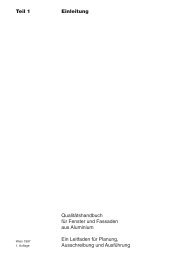Aluminium 2050 Roadmap to a low carbon Europe
Aluminium 2050 Roadmap to a low carbon Europe
Aluminium 2050 Roadmap to a low carbon Europe
- No tags were found...
Create successful ePaper yourself
Turn your PDF publications into a flip-book with our unique Google optimized e-Paper software.
An aluminium <strong>2050</strong> roadmap<strong>to</strong> a <strong>low</strong>-<strong>carbon</strong> <strong>Europe</strong>Lighteningthe load
ElectricityPFC1508000Mio Tonne of CO 2Equivalents1004000A strong aluminium sec<strong>to</strong>r is a key enabler502000for the achievement of EU sustainability goals0In March 2011 the <strong>Europe</strong>an Commission released its Communication‘A <strong>Roadmap</strong> for moving <strong>to</strong> a competitive <strong>low</strong> <strong>carbon</strong> economy in <strong>2050</strong>’(COM(2011)0112), providing scenarios and targets on how different keysec<strong>to</strong>rs - power generation, industry, transport, buildings and construction,as well as agriculture - can make the transition <strong>to</strong> a <strong>low</strong>-<strong>carbon</strong> economyover the coming decades. This leaflet provides a synopsis of the aluminiumindustry’s response <strong>to</strong> the challenges in that communication.100806040Having already reduced its CO 2 equivalent20emissions by a massive 50%, since 1990*,0the aluminium industry has a strong track-20record and is committed <strong>to</strong> further continuous-40improvement <strong>to</strong> help bring about a <strong>low</strong>-<strong>carbon</strong>-60economy in the EU. The extent <strong>to</strong> which-80that commitment can be realised depends-100on a number of fac<strong>to</strong>rs as described be<strong>low</strong>.2010 2020 2030 <strong>2050</strong><strong>Europe</strong>an Industry Imports Savings6000The efforts of the aluminium industry0<strong>to</strong> reduceits direct emissions (-70% in absolute terms),combined with the Commission’s scenario onreductions of emissions from <strong>Europe</strong>an powergeneration (-92%), have the potential <strong>to</strong> delivera <strong>to</strong>tal of 79% reduction in the sec<strong>to</strong>r’s directand indirect emissions by <strong>2050</strong>.kg CO 2eq/<strong>to</strong>nneMio <strong>to</strong>nnes012108642Exports of scrap2008 2020per <strong>to</strong>nnScTotal <strong>Europe</strong>an <strong>Aluminium</strong> CO 2 Equivalent Emissions Reduction60Metal production direct emissionsPerFluorinated Compounds (PFC) emissions50Semi-production Recycling Electricity primary40Mio <strong>to</strong>nnes30-79%201001990 2008 2020 2030 <strong>2050</strong>This scenario assumes the EU electrical power sec<strong>to</strong>rwill achieve the CO 2 intensity reductions projected bythe <strong>Europe</strong>an Commission, and the aluminium sec<strong>to</strong>rwill be able <strong>to</strong> purchase that electricity at internationallycompetitive prices. If the conditions are favourable <strong>to</strong>continued operations and plant upgrades, the aluminiumindustry will invest in <strong>Europe</strong>. Retention of the industryoffers the biggest emissions reduction potential ina global perspective, while safeguarding <strong>Europe</strong>’scompetitiveness, skills and employment.Research in<strong>to</strong> new technologies could eliminate directemissions attributable <strong>to</strong> <strong>carbon</strong> anode consumption,currently the only technology available for the smelting/electrolysis process. The primary plants could begin <strong>to</strong>replace old technology with new non-emitting technologyas soon as it becomes commercially available. This willprobably occur by 2030.* See EAA Sustainability of the aluminium industry 2010 report: www.alueurope.eu/?page_id=160
How do weget there?A positive policy framework is required <strong>to</strong> enablethe aluminium industry <strong>to</strong> contribute its potential for CO 2emissions reductions. In particular, the primary industryin the EU cannot compete with aluminium produced incountries that do not impose CO 2costs in electricity,equivalent <strong>to</strong> the EU Emissions Trading System.Owing <strong>to</strong> our global price referencing platform, the LondonMetal Exchange, we cannot pass through regionally imposedcosts. Our industry will not survive in the EU, unless it is able<strong>to</strong> purchase electricity at internationally competitive prices.The aluminium industry urgently requires enactment of the fol<strong>low</strong>ingEU measures:• The assessment of existing and future proposals on energyand climate change policies and measures <strong>to</strong> ensure internationalcompetitiveness. Among others:• Full compensation for the indirect effect of the Emissions TradingScheme on electricity prices is urgently needed <strong>to</strong> ensure short-termsurvival of the industry, as long as the rest of the world has not adoptedequivalent measures;• Full compensation for renewables costs.• An ambitious EU industry policy giving a 25 years visibility <strong>to</strong> potentialinves<strong>to</strong>rs, including measures <strong>to</strong> develop an adequate framework.At EU level, for the industry <strong>to</strong> adopt bilateral long-term baseloadelectricity contracts.• Support for the aluminium industry <strong>to</strong> help the EU become the bestrecycling society in the world, and the adoption of measures <strong>to</strong> avoidaluminium scrap exports <strong>to</strong> less emissions-efficient regions.• Promotion and development of an innovation policy enabling theindustry <strong>to</strong> retain its technological advantage over the rest of the World.• To encourage the use of lightweighting technologies in transport<strong>to</strong> maximise emissions reductions.• Implementation of a life-cycle approach in all environmental assessments.These measures are also intended <strong>to</strong>:• Maximise the use of aluminium in packaging, therefore safeguardingproduct quality and providing optimal protection properties;• Increase the use of aluminium in building, <strong>to</strong> maximise emissionsreductions through improved energy efficiency.
Challenges forper <strong>to</strong>nnethe <strong>2050</strong> scenarioMio <strong>to</strong>nnes86420kg CO 2eq/<strong>to</strong>nne6000400020000per <strong>to</strong>nne2008 2020 2030 <strong>2050</strong>Mio <strong>to</strong>nnes CO equivalen30 <strong>2050</strong>This scenario is challenged, however, by theEU’s non-competitive electricity prices, attributable<strong>to</strong> the electricity market structure and, in particular, <strong>to</strong> themportsExportsLifeofcyclescrapsavingDomestic usecost of CO 2 in electricity which industry outside the EUdoes not bear. These fac<strong>to</strong>rs have contributed greatly<strong>to</strong> significant <strong>carbon</strong> leakage, resulting in actual andannounced closures and/or capacity reduction. Thisgraph shows the recent and announced closures andtheir impact on the lost capacity.Mio <strong>to</strong>nnes CO 2equivalentsMio <strong>to</strong>nnes203.43.2153.02.8102.62.452.2Evolution of the Primary <strong>Aluminium</strong> Production Capacity in the EU27Primary production Recycling production Imported emissions-15%-18%008 2020 2030 <strong>2050</strong>Mio <strong>to</strong>nnesPFC emissionsUsing From and fuels producing Electricity aluminiumin <strong>Europe</strong> saves resources 5000Electricity primary100003.4 8000kg CO 2eq/<strong>to</strong>nne3.260003.0The consumption of aluminium products-15%is growing in <strong>Europe</strong> (and worldwide), thanks <strong>to</strong>aluminium’s properties and its endless recyclability.If the current loss of competitiveness and closureof primary smelters is not reversed, <strong>Europe</strong> willbecome increasingly dependent on importedprimary0aluminium. This may, in the long run,also negatively affect the fabrication per <strong>to</strong>nne of semifinishedproducts.2.8 40002.620002030 <strong>2050</strong>2.42.22.0-18%2002 2003 2004 2005 2006 2007 2008 2009 2010 2011 2012 2013GHG Economies in CO2 eq by Producing Primary <strong>Aluminium</strong> in <strong>Europe</strong>Mio <strong>to</strong>nnes Kg CO 2eq/<strong>to</strong>nne2.004000 203000153,40020020003,200103,000 150 10002,800502,600 1002,400 02,200 502002 2003 2004 2005 2006 2007 2008 2009 2010 2011 2012 2013No <strong>Europe</strong>an No <strong>Europe</strong>an No primary Current statusproduction recycling in <strong>Europe</strong>(2008)<strong>Europe</strong>an Consumption of <strong>Aluminium</strong> by Market Sec<strong>to</strong>rs (forecast)TransportEngineering201094% reduction 2010 vs 1990Building PackagingOther-15%1990 1995 2000 2002 2005 2007 2008 2009 2010-18%2020 2030 <strong>2050</strong>Kg CO 2eq/<strong>to</strong>nne5000Mio <strong>to</strong>nnes CO 2equivalents4000300020002015105Primary production Recycling production Imported emissions94% reduction 2010 vs 19902,000Without <strong>Europe</strong>an aluminium primary production and022recycling,2002 2003and2004based2005on2006the 2007average2008 2009worldwide2010 2011 2012energy2013mix, <strong>Europe</strong> would be responsible for 178% more20emissions, as the imported metal would have a largerCO182 footprint than the displaced EU production. Recentdevelopment of <strong>Europe</strong>an and global emissions dataindicates 16 that this number will increase further.MWh/t141000001990 1995 2000 2002 2005 2007 2008 2009 2010 1950 1960 1970 1980 1990 2000 2010The sec<strong>to</strong>r’s <strong>to</strong>tal emissions are more than compensatedfor by the emissions reductions obtained throughthe use of aluminium in transport, as reductionsfrom vehicle emissions attributable <strong>to</strong> aluminium20 Transport Building Packaginglightweighting save 70 million <strong>to</strong>nnes of CO 2 perannum. When Engineering considering Other the whole product life-cycle,additional 15 emissions reductions are also achievablein applications such as packaging (i.e. longer shelf life)or energy efficient buildings (both new and renovated).Mio <strong>to</strong>nnes105No <strong>Europe</strong>anproductionNo <strong>Europe</strong>anrecyclingNo primaryin <strong>Europe</strong>Current status(2008)Mio <strong>to</strong>nnes of CO 2equivalents100806040200-20-40-60-80-1001210GHG Balance - Production and Imports vs. GHG Savings2010 2020 2030 <strong>2050</strong><strong>Europe</strong>an production of aluminium Imports Life cycle saving02010 2020 2030 <strong>2050</strong>Note: The savings of specific CO 2/kg aluminium, attributable <strong>to</strong> aluminium in au<strong>to</strong>motiveand transport applications is projected <strong>to</strong> decline after 2030, owing <strong>to</strong> increased efficiencyof engines and power trains.
10000-15%8000Continued growth in6000recycling will play a key role10000From fuels -18% Electricity10000kg CO 2eq/<strong>to</strong>nne4000 ElectricityElectricityPFCAnodesPFCOtherAnodesOther10000kg CO 2eq/<strong>to</strong>nne-15% 80006000Recycling is critical <strong>to</strong> sustainable development.It al<strong>low</strong>s resources <strong>to</strong> be saved and waste <strong>to</strong> be 6000 reduced.Used aluminium is valuable; it is easily and endlessly-18%recyclable without loss of quality. Both recycled 4000 andprimary metal will be needed <strong>to</strong> meet projected increasedconsumption of aluminium in <strong>Europe</strong>. Just as for 2000 primaryaluminium smelting, the conditions must be right <strong>to</strong>0facilitate the growth of recycling in <strong>Europe</strong>. This is 0 allper <strong>to</strong>nnethe more important given that recycling aluminiumsaves up <strong>to</strong> 95% of the energy required forprimary production.2007 2008 2009 2010 2011 2012 201340002000010 2011 2012 2013kg CO 2eq/<strong>to</strong>nne8000200001210per <strong>to</strong>nneProjection of <strong>Europe</strong>an Scrap Availability & Exports Until <strong>2050</strong>per <strong>to</strong>nneExports of scrap Domestic usekg CO 2eq/<strong>to</strong>nne80006000400020000Mio <strong>to</strong>nnes CO 2equivalentsIn this context, it is essential <strong>to</strong> reverse the dramaticincrease in the export of aluminium scrap from<strong>Europe</strong>. The importers in other regions are 12“capturing” a key <strong>Europe</strong>an resource. Exported10aluminium scrap should be considered as exported<strong>Europe</strong>an electricity, without compensation for the8embodied CO 2 .2015100 5 2030 <strong>2050</strong>0No <strong>Europe</strong>an No <strong>Europe</strong>an No primary Current 0status3.4production recycling(2008)Building on already impressive powerin <strong>Europe</strong>3.2<strong>2050</strong>3.0and emissions intensity reductionsaluminium Imports Life cycle savingortsMio <strong>to</strong>nnesirect emissions86Exports 4 of scrap Domestic use202008 2020 2030 <strong>2050</strong>As primary aluminium smelting is highly power-intensive, power constitutes up 2.4<strong>to</strong> 40 per cent3.220or more of Transport smelter operating Building costs. Packaging Therefore, the industry is driven <strong>to</strong> minimize2.2power consumption,as illustrated be<strong>low</strong>. As further efficiencies are limited by existing 3.0technology, medium-term emissionsEngineering Other2.0reductions from power use will be dependent, primarily, on obtaining cleaner power at internationally152.8competitive prices. As the industry has also reduced direct emissions as far as is possible2.6with existing technology, further direct emissions reductions are dependent on thePFC emissions10 anticipated technology breakthrough. Further cost burdens 2.4 imposed by policy on the sec<strong>to</strong>rElectricity primarywould hasten neither further direct emissions reduction nor power use reductions and would only2.2result in increased <strong>carbon</strong> leakage.Life cycle savingRecycling5Primary production Recycling production Imported emissionsMio <strong>to</strong>nnes642Mio <strong>to</strong>nnes2008 2020 2030 <strong>2050</strong>Mio <strong>to</strong>nnes3.42.0Mio <strong>to</strong>nnes2.82.6-15%--15%2002 2003 2004 2005 2006 2007 2008 2009 2010 2011 2012-18%2002 2003 2004 5000 2005 2006 2007 2008 2009 2010 2011 2012 2013Mio <strong>to</strong>nnes CO 2equivalentsMio <strong>to</strong>nnes2110PFC emissions20102020 2030 <strong>2050</strong>400094% reduction 2010 vs 1990Electricity primaryReduced Electricity Consumption at the Electrolysis Stage –Best Available Technique Improvements, <strong>Europe</strong>*222020 2030 <strong>2050</strong><strong>2050</strong>004000Kg CO 2eq/<strong>to</strong>nne3000PFC Emissions from Primary <strong>Aluminium</strong> Production <strong>Europe</strong>200094% reduction 2010 vs 19901000MWh/t18162030 14 <strong>2050</strong>Kg CO 2eq/<strong>to</strong>nne3000200001990 1995 2000 2002 2005 2007 2008 2009MWh/t121000101950 1960 1970 1980 1990 2000 201001990 1995 2000 2002 2005 2007 2008 2009 2010*Total electricity consumption includes a number of additional consumptions
The benefits of apermanent materialThe demand for aluminium products is steadily increasing year by year. Why?On <strong>to</strong>p of worldwide demographic growth and higher purchasing power in emergingcountries, aluminium product consumption is also growing in <strong>Europe</strong> becausealuminium is replacing other materials thanks <strong>to</strong> its unique combination of properties,such as lightweight, strength, corrosion-resistance, durability, ductility, formability,conductivity and endless recyclability. We cannot fly, travel by high speed train,high performance car or fast ferry without it. We cannot get heat and light in<strong>to</strong> ourhomes and offices without it. Our society depends on it <strong>to</strong> preserve food, medicineand provide electronic components for our computers.<strong>Aluminium</strong> is part of our daily lives because it offers intelligent solutions<strong>to</strong> our needs!<strong>Aluminium</strong> industry key facts and figures<strong>Europe</strong> (excluding Russia) 2010Imports in<strong>to</strong> <strong>Europe</strong>Direct jobs.........................................................................................................255.000% of <strong>to</strong>talMt Mt consumptionMining ..............................................................................................................................3.2 11.9 79%Refining (alumina)....................................................................................................6.5 4.5 41%Primary production................................................................................................4.4Recycling.......................................................................................................................4.3Production of semisRolled products.......................................................................................4.5Extrusions....................................................................................................3.1Castings........................................................................................................3.4Wire, slugs, powder.............................................................................1.23.8 30%About the EAAThe <strong>Europe</strong>an <strong>Aluminium</strong> Association (EAA) was founded in 1981 and representsthe aluminium industry in <strong>Europe</strong>. It encompasses primary aluminium producers,downstream manufacturers, producers of recycled aluminium and national aluminiumassociations representing the manufacturers of rolled and extruded products in18 <strong>Europe</strong>an countries. Other associations, the Organisation of <strong>Europe</strong>an <strong>Aluminium</strong>Recyclers (OEA) and the <strong>Europe</strong>an <strong>Aluminium</strong> Foil Association (EAFA), are alsomembers of the EAA.Contact usAv. de Broqueville 12B-1150 BrusselsTel: +32 (0)2 775 63 63Fax: +32 (0)2 779 05 31eaa@aluminium.orgwww.alueurope.euFebruary 2012. Source of data: EAA, IAI, OEA.


